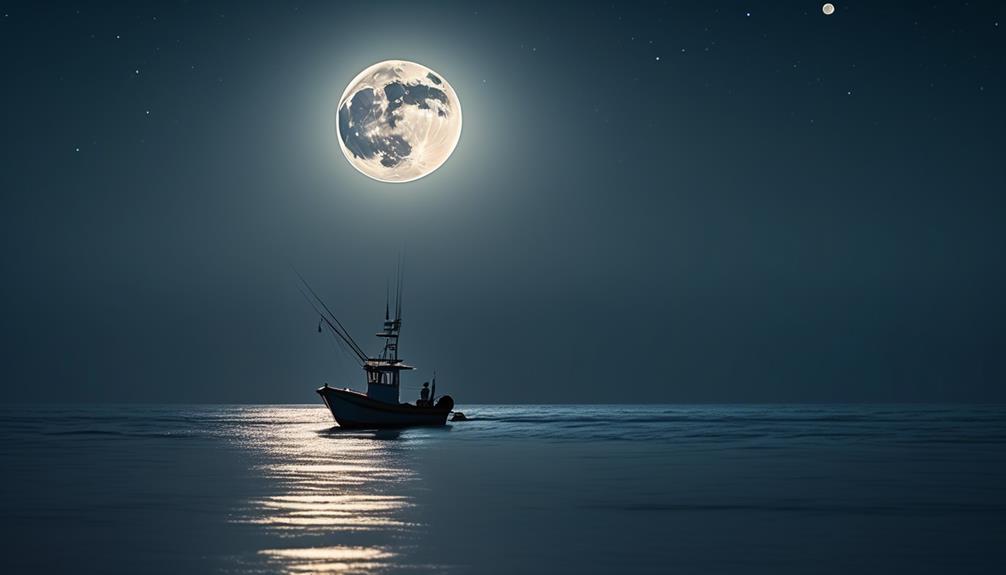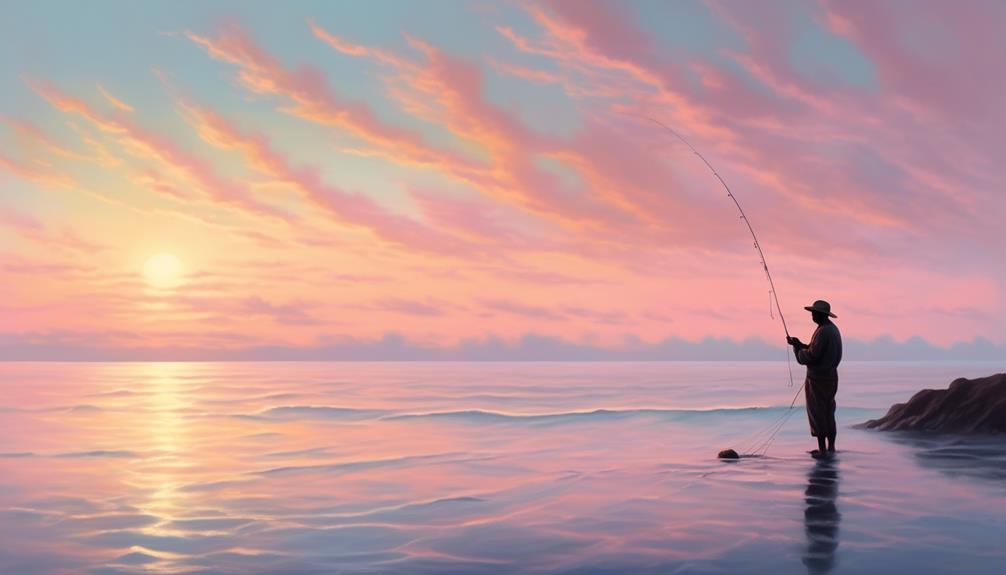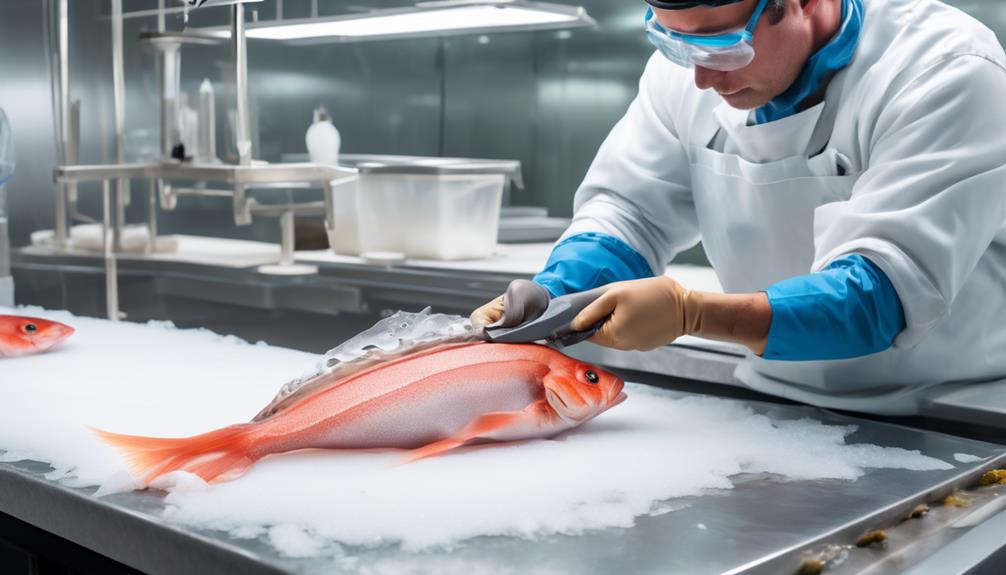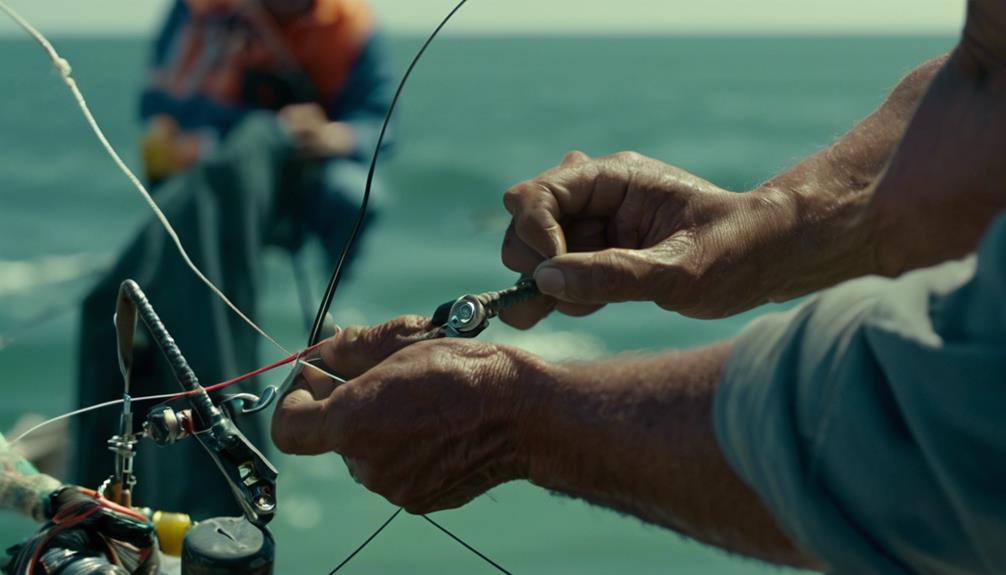If you're looking to reel in some big catches, consider this: 90% of saltwater fish are found in only 10% of the ocean.
When it comes to saltwater fishing, timing is everything. You might be surprised to learn that the best times to fish aren't always when you'd expect. From the crack of dawn to the dead of night, there are specific windows of opportunity that can significantly increase your chances of landing a trophy fish.
But what are these ideal times, and why do they matter?
Early Morning
For successful saltwater fishing, head out early in the morning when the fish are most active. The early hours offer a prime opportunity to capitalize on the feeding habits of saltwater species. When selecting your tackle for early morning saltwater fishing, consider using topwater lures or shallow diving plugs. These mimic the movement of prey on the water's surface, attracting fish that are actively feeding. Additionally, utilizing live bait such as shrimp or mullet can be highly effective during this time.
As you head out to fish in the early morning, it's essential to employ the right fishing techniques. One effective method is to target areas with structure, such as jetties, piers, or mangroves, as these provide shelter and feeding grounds for various saltwater species during the early hours. Another technique to consider is drift fishing, especially if you're targeting species like mackerel or tarpon. Drifting with the current allows you to cover a larger area and increase your chances of encountering active feeding fish.
When the sun is just beginning to rise, fish tend to be more active near the surface, making it an ideal time to utilize surface lures and engage in topwater fishing. Keep in mind that the early morning hours are also less crowded, offering a serene and peaceful fishing experience.
Sunrise
At sunrise, position yourself where the sunlight hits the water, as this is when many saltwater species become most active and visible near the surface. This magical time of day offers you the best chance to hook a variety of prized catches.
To make the most of your sunrise fishing expedition, consider the following tips:
- Tackle Selection
- Opt for lightweight tackle to mimic the natural movement of baitfish as they shimmer in the early morning light. A 7-foot medium-action rod paired with a 3000 series spinning reel is well-suited for casting smaller lures or live bait.
- Bait Choices
- Experiment with topwater lures to take advantage of the low light conditions and entice predatory fish to strike. Consider using poppers, walk-the-dog lures, or surface plugs to create enticing surface disturbances that mimic distressed baitfish.
- Positioning
- Strategically position yourself near structures such as jetties, piers, or mangroves where fish are likely to congregate in the early morning to feed. These structures offer shade and protection for baitfish, which in turn attract larger predatory fish seeking an easy meal.
As the sun rises, it illuminates the water's surface, providing a breathtaking backdrop as you cast your line. With the right tackle, bait choices, and positioning, you'll be primed to capitalize on the heightened activity of saltwater species during this magical time of day.
Incoming Tide
Position yourself strategically along the shoreline to take advantage of the increased water movement during the incoming tide, a prime opportunity to target a diverse range of saltwater species. As the tide comes in, it brings with it a rush of nutrients and baitfish, attracting larger predatory fish closer to the shore. This creates an ideal environment for successful fishing.
During the incoming tide, using the best bait can significantly increase your chances of a successful catch. Live bait such as shrimp, mullet, or menhaden are particularly effective during this time as they mimic the natural prey that predatory fish are actively seeking in the moving water. Artificial lures that resemble these baitfish can also be productive in enticing strikes from hungry fish.
Identifying prime fishing spots along the shoreline during the incoming tide is crucial for a successful fishing trip. Look for areas where the water is funneled through narrow channels or around points, as these locations can concentrate baitfish and predatory species. Additionally, structures such as jetties, piers, and rocky outcrops can disrupt the water flow, creating eddies and pockets where fish may be waiting to ambush passing prey.
As the incoming tide increases the water level, it allows predatory fish to move closer to the shore in search of food, presenting an excellent opportunity for anglers to target a variety of saltwater species. By positioning yourself strategically and using the right bait in prime fishing spots, you can maximize your chances of a successful catch during this optimal time for saltwater fishing.
High Tide
Taking advantage of the increased water level during high tide, you can target a diverse range of saltwater species for successful fishing. High tide presents an opportune time for anglers due to the abundance of marine life brought closer to shore. During this phase of the tidal patterns, various fishing techniques can be employed to maximize your catch.
- Prime Spots: At high tide, submerged structures such as rocks, jetties, and piers become excellent hiding spots for predatory fish seeking refuge in the deeper water. This creates an ideal opportunity for you to target species like snook, redfish, and striped bass that gravitate towards these areas to feed.
- Shoreline Feeding Frenzy: As the water rises, baitfish and other smaller marine creatures move closer to the shore, attracting larger predatory fish. Utilize topwater lures or live bait to capitalize on this feeding frenzy, as game fish such as tarpon and bluefish actively hunt in the shallows during high tide.
- Inlet and Estuary Action: High tide causes an influx of water into inlets and estuaries, leading to increased water flow. This surge of water brings in a variety of fish species, including flounder, speckled trout, and snapper, making it an optimal time to employ techniques like drift fishing with live bait or casting with soft plastic lures.
Sunset
As the sun begins to dip below the horizon, the vibrant colors of the sky signal the transition to a prime time for saltwater fishing. Sunset is a magical time to be out on the water, and it's also an ideal time to catch some great fish. When it comes to bait selection during the sunset hours, it's important to choose baits that are highly visible in low light conditions. Brightly colored lures or those with reflective surfaces can be particularly effective during this time. Additionally, live bait such as shrimp or mullet can also be successful choices as they're attractive to fish and maintain their liveliness in the cooler evening temperatures.
Furthermore, tackle maintenance is crucial during sunset fishing. As the light starts to fade, it becomes more challenging to see and handle your equipment. It's essential to ensure that your tackle is well-organized and in good condition. Check your lines for any signs of wear and re-tie if necessary. Make sure your reels are properly lubricated and functioning smoothly. This attention to detail can prevent frustrating tangles or equipment malfunctions when you have a bite on the line.
Nighttime
Now that the sun has set, the night brings a new set of challenges and opportunities for saltwater fishing. Nighttime fishing can be an exhilarating experience, offering a different atmosphere and a chance to catch some unique species. Here are some reasons why nighttime fishing can be rewarding:
- Serenity under the Moon: Picture yourself on a moonlit excursion, with the calm waters gently reflecting the moon's glow. The peaceful ambiance adds an extra layer of tranquility to your fishing experience. The silvery light creates an enchanting backdrop as you cast your line, making the whole adventure feel almost magical.
- Thrill of the Hunt: As darkness falls, predatory fish become more active, seeking their next meal. This presents a great opportunity for anglers to target these nocturnal feeders. The thrill of feeling a strong tug on your line in the dead of night adds an element of excitement to your fishing expedition.
- Cooler Temperatures: The cooler air at night can provide relief from the heat of the day, making it more comfortable to fish for extended periods. The absence of the scorching sun allows you to focus entirely on the fishing, without the distraction of the sweltering heat.
The nighttime offers a unique and captivating setting for saltwater fishing, and embracing this different experience can lead to memorable and rewarding catches.
Full Moon

During a full moon, you may notice an increase in fish activity, making it an opportune time for saltwater fishing. The lunar influence on fish behavior is well-documented, and during a full moon, this influence is particularly strong. Fish tend to be more active and feeding during this phase of the lunar cycle. The increased light during the night of a full moon can also lead to changes in bait behavior, which in turn affects the feeding patterns of many saltwater fish species.
Full moons have a significant impact on the behavior of various marine creatures, including fish. The increased illumination provided by a full moon can trigger a chain reaction in the marine ecosystem. For example, certain species of baitfish may move closer to the surface during a full moon night, which in turn attracts larger predatory fish. This can create excellent fishing opportunities, as predatory fish become more active and are on the hunt for prey.
When planning a saltwater fishing trip, it's worth considering the lunar calendar and specifically targeting the days around the full moon. This period often provides prime conditions for successful fishing. Whether you're targeting species that are known to be more active during a full moon or taking advantage of the changes in bait behavior, fishing during a full moon can be a rewarding experience.
Changing Weather
The influence of changing weather on saltwater fishing can significantly impact the behavior and feeding patterns of marine creatures, presenting both challenges and opportunities for anglers seeking a successful catch.
When considering seasonal patterns, temperature plays a crucial role in the movement and feeding habits of fish. In warmer seasons, such as summer, many species tend to move into shallower waters in search of cooler temperatures and increased oxygen levels. Conversely, during cooler seasons like winter, fish often migrate to deeper waters where the temperature is more stable.
Another vital aspect affected by changing weather is wind direction, which can greatly influence the distribution of baitfish and subsequently attract predatory fish. For instance, a prevailing wind from the east can push warm surface waters toward the western shore, concentrating baitfish and attracting predatory species. On the other hand, a west wind can disperse surface baitfish, making it more challenging to locate productive fishing spots.
Furthermore, barometric pressure, a key indicator of changing weather conditions, can significantly impact fish behavior. As a general rule, many anglers find that fishing can be most productive when the barometric pressure is stable or rising. A falling barometer, often preceding a storm, may cause fish to become less active and feed less frequently.
Understanding how seasonal patterns, temperature, wind direction, and barometric pressure can influence fish behavior is crucial for maximizing your saltwater fishing success. By adapting your fishing approach to changing weather conditions, you can increase your chances of a rewarding catch.
Frequently Asked Questions
What Are the Best Types of Bait to Use During the Early Morning for Saltwater Fishing?
During the early morning, the best lures for saltwater fishing are live bait such as shrimp, mullet, and squid. Ideal spots to catch fish during this time are near shallow areas and close to structures like jetties and piers.
How Can I Adjust My Fishing Technique During a Changing Weather Pattern While Saltwater Fishing?
When adjusting your fishing technique during changing weather patterns while saltwater fishing, pay attention to the water temperature and movement. Use bait that suits the conditions and consider safety precautions for nighttime fishing.
Are There Any Specific Safety Precautions I Should Take While Fishing During Nighttime in Saltwater?
When fishing at night in saltwater, make sure to take safety precautions. Bring essential equipment such as a reliable light source, a first aid kit, and communication devices. Always be aware of your surroundings and potential hazards.
What Are Some Common Mistakes to Avoid When Fishing During High Tide in Saltwater?
When fishing during high tide in saltwater, common mistakes to avoid include using the wrong bait types and not adjusting your fishing technique for the strong currents. Early morning is ideal for saltwater fishing.
What Are the Best Locations to Fish From During a Full Moon for Saltwater Fishing?
For the best fishing spots during a full moon, head to shallow areas with strong currents. Use light tackle and gear for full moon fishing. Look for feeding activity and cast your line near the action.
Conclusion
So, whether you prefer the peacefulness of early morning or the excitement of nighttime, there are plenty of ideal times for saltwater fishing.
Keep an eye on the tide, weather, and moon phases to maximize your chances of a successful catch.
And don't forget to enjoy the beauty of the ocean while you're out there!
Happy fishing!



